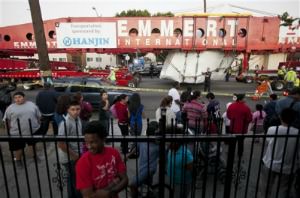On the Big Rock
My largest problem with "Levitated Mass" is not with its artistic quality (or lack of quality), but rather with the excessive cost of the process.If LACMA wants to call Heizer's "creation" art, let that appellation stand, but art can and should be subject to critical judgment.
In late February and early March, Southern Californians were inundated with stories, in both print and electronic media, about the latest art fad to capture public attention: the transportation and arrival of the “big rock” to the Los Angeles County Museum of Art. Known formally as “Levitated Mass,” the work by reclusive artist Michael Heizer is a 340-ton, 21-foot-high boulder that made a 105-mile journey from a Riverside County quarry to the museum, proceeding at night in a highly complicated endeavor at 4 to 5 miles per hour over an 11-night period. The transporter for this gargantuan public art piece was itself 200 feet long, with 196 wheels, that required complex engineering and logistical calculations, including dozens of workers involved in the move across three Southern California counties.
The project also carries a high price. It is estimated to cost approximately $10 million, funded primarily through private donations. The Los Angeles County Museum of Art paid $70,000 to the quarry for the big rock. Now that it has arrived, it will be installed on LACMA’s grounds over a cut in the earth and available for public viewing in the fall. Museum officials, including Director Michael Govan, appear ecstatic about the project. He told The New York Times that “it fits into a grand tradition of using public space.” Some art aficionados are equally enthusiastic, viewing “Levitated Mass” as a major addition to LACMA’s public art offerings. Heizer himself, who has produced conventional small sculptures and large earthworks throughout his career, has been characteristically silent about his effort.
The enthusiasm about the big rock, however, is far from universal. Indeed, many public comments on the Internet and in private conversations have been especially scornful, wondering whether the big rock is really a big joke and a phenomenal waste of money, despite the fact that the move itself has likely produced a modest, if temporary, spike in employment. Although no major public opinion poll about the big rock is available (nor will one likely be commissioned), it is realistic to assume that the general public is probably indifferent or even hostile to this highly publicized event. Many critics even ask the perennial question: Is it really art?
Negative public opinion about art can be wrong, even dangerous. It can lead to cultural censorship and can reinforce philistine and anti-intellectual attitudes, especially in a society in which these values remain pervasive. The past is replete with cases in which outstanding artworks encountered initial public hostility and yet in retrospect made significant contributions to American art history and cultural life. And debating whether something is art or not is often fruitless. If LACMA wants to call Heizer’s “creation” art, let that appellation stand, but art can and should be subject to critical judgment.
In this case, dismissive and acerbic public reaction about the big rock is close to the mark. A large boulder displayed at a major art museum may well offer viewers some modest appreciation of the natural environment, and the rock itself — to stretch a point — has some natural aesthetic qualities. Overall, however, this artwork is basically silly. To compare it with the genuinely outstanding works in LACMA’s collection is absurd. No amount of critical artistic discourse, often intended to reinforce a smug and insular cultural and academic elitism, can justify a transparent public relations ploy that uses art as a cover. The big rock reveals nothing excellent, or even very interesting, at either the level of form or content. Future historians are unlikely to include it in the larger canon of significant early 21st century art, a prediction I make here with confidence.
The intense publicity of the big rock’s journey has encouraged me to ask others about their opinions on the issue. I posed the question to 35 students in my honors course on social commentary in art at UCLA. Not surprisingly, their opinions overwhelmingly mirrored those of the public who find the big rock ludicrous. My students have spent an entire term studying such artistic giants as Francisco Goya, Honore Daumier, Kathe Kollwitz, Elizabeth Catlett, Ben Shahn, Diego Rivera, Barbara Kruger and many others, including some artists addressing contemporary environmental concerns. Although Heizer’s land works like “Double Negative,” a 1,500-foot trench in the Nevada desert 40 years ago, deserve mention in this context for their striking visual presence and nontraditional use of space, his “Levitated Mass” will generate environmental consciousness only to viewers capable of serious delusion. A brief trip to the Santa Monica Mountains, Griffith Park or anywhere else in the area before rapacious developers descend would be a far more valuable experience.
Equally significant, I have conversed with several prominent Los Angeles area artists, especially from the minority community, about the big rock. Their views are unanimous: This is a ludicrous publicity stunt that ill befits the Los Angeles County Museum of Art, which has impressively hosted several exhibitions under the widely heralded Pacific Standard Time initiative. These creative women and men have worked for decades producing powerful works addressing social, ethical, historical and aesthetic issues. Their critique — indeed, their contempt — for the hoopla surrounding the big rock should be taken seriously. My largest problem, however, with “Levitated Mass” is not with its artistic quality (or lack of quality), but rather with the excessive cost of the process. The private donors who spent upward of $10 million for this “event” are perfectly free to deploy their funds any way they wish. I take no issue with their legal and moral rights, but rather with their judgment, especially in an era of precarious financial distress for the arts in general.
Some recent Los Angeles examples are disconcertingly useful in establishing a broader context for my critical observations. In 2007, the black-owned Golden State Mutual Life Insurance company sold off most of its collection of original artworks from its historic West Adams building in an unsuccessful attempt to save the firm from insolvency. New York’s Swann Auction Galleries sold 94 artworks from the Golden State collection for a total of $1.54 million.
For approximately 20 years, I conducted tours of the building for university students and community groups, especially young people. During those tours, I used the now-departed artworks to offer insights about African-American history in general and Los Angeles art and history in particular. I doubt that the big rock will afford me similar educational opportunities.
For many years, moreover, Los Angeles was known as the mural capital of the world. More than 1,000 of these vibrant public works beautified neighborhoods and offered communities access to art of exemplary quality, often produced by first-rate painters for whom social and historic themes were of paramount importance. Unfortunately, hundreds of these murals have deteriorated dramatically through the ravages of time, neglect, environmental degradation and vandalism. Only a few have been repaired and no systematic restoration program in Los Angeles exists; the cost would be a mere fraction of the expenses for the big rock.
Everyone has noticed the extreme budgetary cutbacks in local public schools, a reality that is unfortunately national in scope. As usual, arts programs are among the earliest victims of the budgetary ax. Draconian cuts have reduced or eliminated arts programs throughout the schools, keeping young people from pursuing their creative interests and in some cases from more destructive activity on neighborhood streets. Arts education has hugely valuable consequences both for the recipients and for society. I can only imagine what even a fraction of the $10 million for the big rock might do in restoring this essential feature of the educational process.
Most distressingly, Los Angeles is full of dynamic and gifted artists but only a handful has achieved widespread recognition with little problem attracting exhibition venues. Thousands struggle to maintain marginal lifestyles while still producing their artworks. The infusion of even a modest amount of money into community galleries and small grant funds would be monumentally helpful — not only for the material resources, but for the recognition that these artists’ work has value in society. A fragment of the big rock cost could go a long way toward this valuable objective.
Now that the big rock has been delivered to LACMA, the ballyhoo has only increased. But sound and fury of its triumphant entry will fade quickly and justifiably into obscurity, like all the artistic fads before it.
Your support is crucial…With an uncertain future and a new administration casting doubt on press freedoms, the danger is clear: The truth is at risk.
Now is the time to give. Your tax-deductible support allows us to dig deeper, delivering fearless investigative reporting and analysis that exposes what’s really happening — without compromise.
Stand with our courageous journalists. Donate today to protect a free press, uphold democracy and unearth untold stories.






You need to be a supporter to comment.
There are currently no responses to this article.
Be the first to respond.